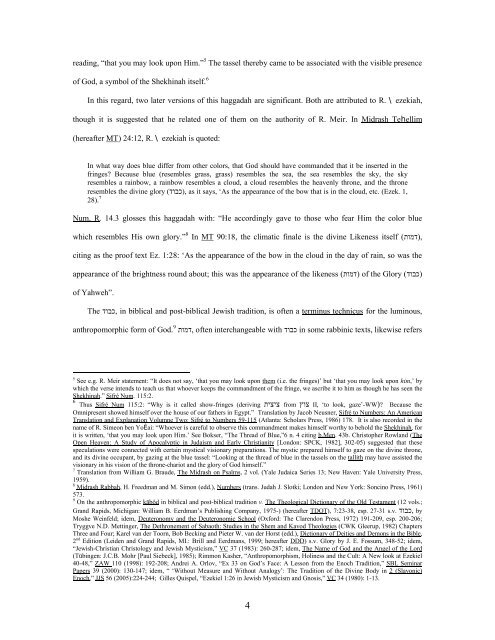Sapphiric God: - Dr. Wesley Muhammad
Sapphiric God: - Dr. Wesley Muhammad
Sapphiric God: - Dr. Wesley Muhammad
Create successful ePaper yourself
Turn your PDF publications into a flip-book with our unique Google optimized e-Paper software.
eading, “that you may look upon Him.” 5 The tassel thereby came to be associated with the visible presence<br />
of <strong>God</strong>, a symbol of the Shekhinah itself. 6<br />
In this regard, two later versions of this haggadah are significant. Both are attributed to R. \ezekiah,<br />
though it is suggested that he related one of them on the authority of R. Meir. In Midrash Tehellim<br />
(hereafter MT) 24:12, R. \ezekiah is quoted:<br />
In what way does blue differ from other colors, that <strong>God</strong> should have commanded that it be inserted in the<br />
fringes? Because blue (resembles grass, grass) resembles the sea, the sea resembles the sky, the sky<br />
resembles a rainbow, a rainbow resembles a cloud, a cloud resembles the heavenly throne, and the throne<br />
resembles the divine glory (דובכ), as it says, ‘As the appearance of the bow that is in the cloud, etc. (Ezek. 1,<br />
28). 7<br />
Num. R. 14.3 glosses this haggadah with: “He accordingly gave to those who fear Him the color blue<br />
which resembles His own glory.” 8 In MT 90:18, the climatic finale is the divine Likeness itself (תומד),<br />
citing as the proof text Ez. 1:28: ‘As the appearance of the bow in the cloud in the day of rain, so was the<br />
appearance of the brightness round about; this was the appearance of the likeness (תומד) of the Glory (דובכ)<br />
of Yahweh”.<br />
The דובכ, in biblical and post-biblical Jewish tradition, is often a terminus technicus for the luminous,<br />
anthropomorphic form of <strong>God</strong>. 9 תומד, often interchangeable with דובכ in some rabbinic texts, likewise refers<br />
5 See e.g. R. Meir statement: “It does not say, ‘that you may look upon them (i.e. the fringes)’ but ‘that you may look upon him,’ by<br />
which the verse intends to teach us that whoever keeps the commandment of the fringe, we ascribe it to him as though he has seen the<br />
Shekhinah.” Sifré Num. 115:2.<br />
6 Thus Sifré Num 115:2: “Why is it called show-fringes (deriving תיציצ<br />
from ץוצ II, ‘to look, gaze’-WW)? Because the<br />
Omnipresent showed himself over the house of our fathers in Egypt.” Translation by Jacob Neusner, Sifré to Numbers: An American<br />
Translation and Explanation Volumne Two: Sifré to Numbers 59-115 (Atlanta: Scholars Press, 1986) 178. It is also recorded in the<br />
name of R. Simeon ben YoÈai: “Whoever is careful to observe this commandment makes himself worthy to behold the Shekhinah, for<br />
it is written, ‘that you may look upon Him.’ See Bokser, “The Thread of Blue,”6 n. 4 citing b.Men. 43b. Christopher Rowland (The<br />
Open Heaven: A Study of Apocalyptic in Judaism and Early Christianity [London: SPCK, 1982], 302-05) suggested that these<br />
speculations were connected with certain mystical visionary preparations. The mystic prepared himself to gaze on the divine throne,<br />
and its divine occupant, by gazing at the blue tassel: “Looking at the thread of blue in the tassels on the tallith may have assisted the<br />
visionary in his vision of the throne-chariot and the glory of <strong>God</strong> himself.”<br />
7 Translation from William G. Braude, The Midrash on Psalms, 2 vol. (Yale Judaica Series 13; New Haven: Yale University Press,<br />
1959).<br />
8 Midrash Rabbah, H. Freedman and M. Simon (edd.), Numbers (trans. Judah J. Slotki; London and New York: Soncino Press, 1961)<br />
573.<br />
9 On the anthropomorphic kābôd in biblical and post-biblical tradition v. The Theological Dictionary of the Old Testament (12 vols.;<br />
Grand Rapids, Michigan: William B. Eerdman’s Publishing Company, 1975-) (hereafter TDOT), 7:23-38, esp. 27-31 s.v. דובכ, by<br />
Moshe Weinfeld; idem, Deuteronomy and the Deuteronomic School (Oxford: The Clarendon Press, 1972) 191-209, esp. 200-206;<br />
Tryggve N.D. Mettinger, The Dethronement of Sabaoth: Studies in the Shem and Kavod Theologies (CWK Gleerup, 1982) Chapters<br />
Three and Four; Karel van der Toorn, Bob Becking and Pieter W. van der Horst (edd.), Dictionary of Deities and Demons in the Bible,<br />
2 nd Edition (Leiden and Grand Rapids, MI.: Brill and Eerdmans, 1999; hereafter DDD) s.v. Glory by J. E. Fossum, 348-52; idem,<br />
“Jewish-Christian Christology and Jewish Mysticism,” VC 37 (1983): 260-287; idem, The Name of <strong>God</strong> and the Angel of the Lord<br />
(Tübingen: J.C.B. Mohr [Paul Siebeck], 1985); Rimmon Kasher, “Anthropomorphism, Holiness and the Cult: A New look at Ezekiel<br />
40-48,” ZAW 110 (1998): 192-208; Andrei A. Orlov, “Ex 33 on <strong>God</strong>’s Face: A Lesson from the Enoch Tradition,” SBL Seminar<br />
Papers 39 (2000): 130-147; idem, “ ‘Without Measure and Without Analogy’: The Tradition of the Divine Body in 2 (Slavonic)<br />
Enoch,” JJS 56 (2005):224-244; Gilles Quispel, “Ezekiel 1:26 in Jewish Mysticism and Gnosis,” VC 34 (1980): 1-13.<br />
4
















